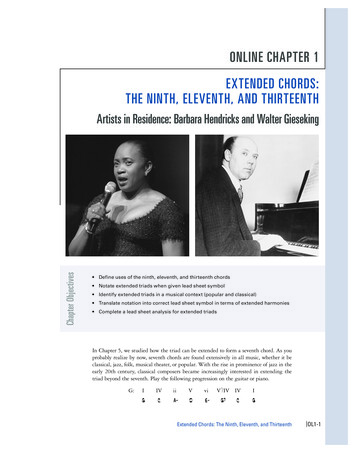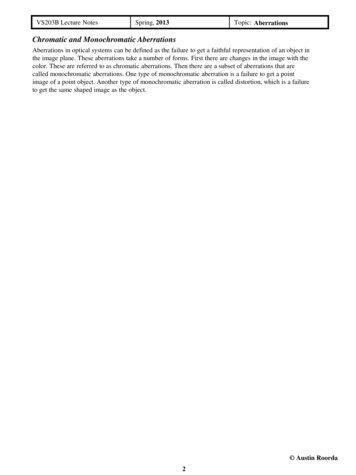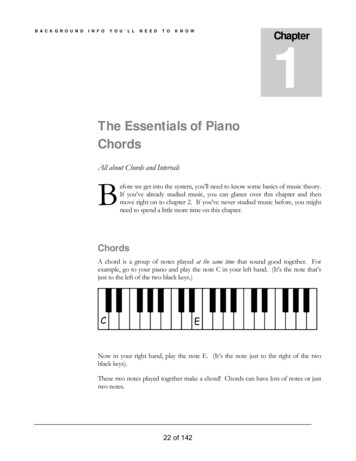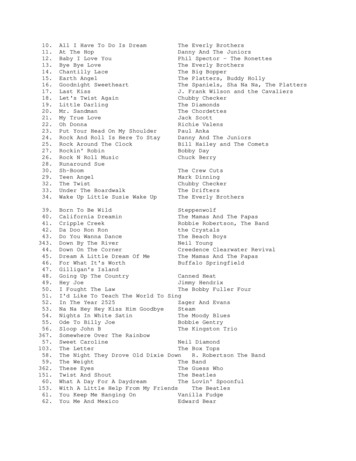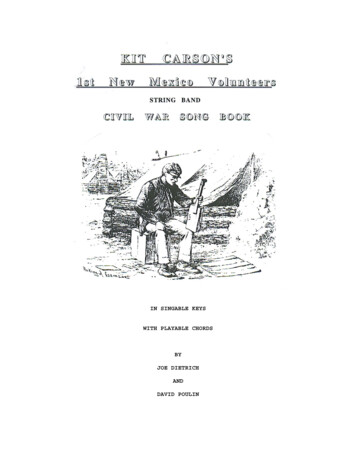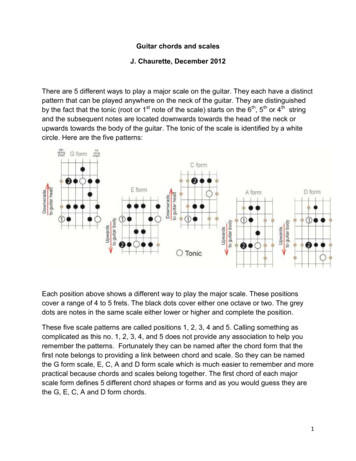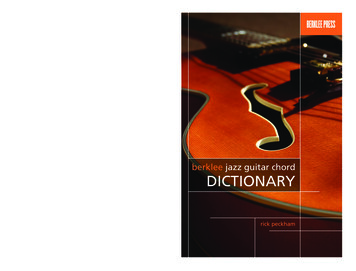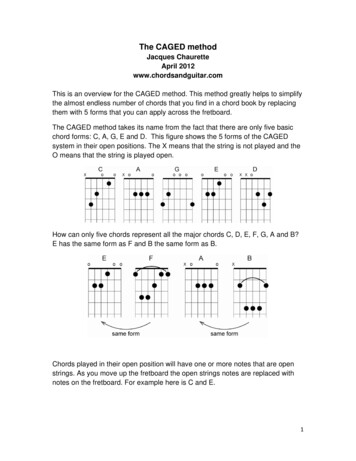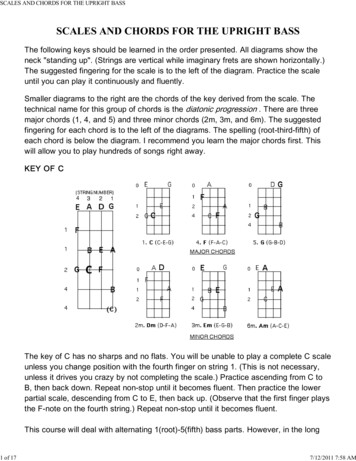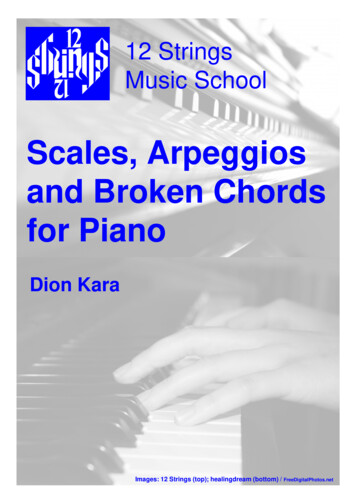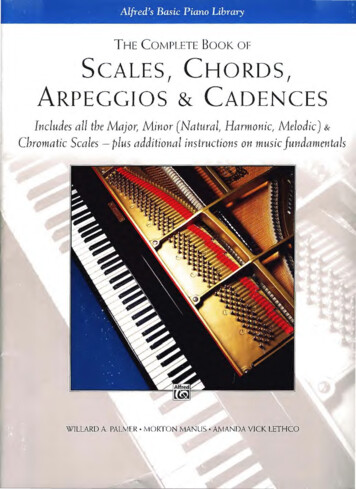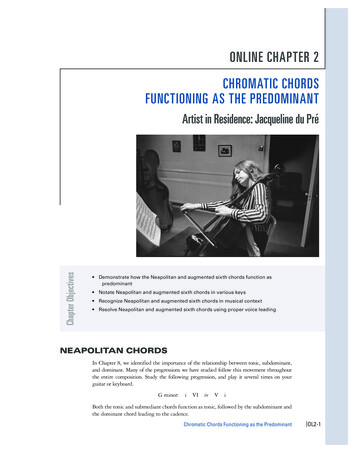
Transcription
ONLINE CHAPTER 2CHROMATIC CHORDSFUNCTIONING AS THE PREDOMINANTChapter ObjectivesArtist in Residence: Jacqueline du Pré Demonstrate how the Neapolitan and augmented sixth chords function aspredominant Notate Neapolitan and augmented sixth chords in various keys Recognize Neapolitan and augmented sixth chords in musical context Resolve Neapolitan and augmented sixth chords using proper voice leadingNEAPOLITAN CHORDSIn Chapter 8, we identified the importance of the relationship between tonic, subdominant,and dominant. Many of the progressions we have studied follow this movement throughoutthe entire composition. Study the following progression, and play it several times on yourguitar or keyboard.G minor:iVIivViBoth the tonic and submediant chords function as tonic, followed by the subdominant andthe dominant chord leading to the cadence.Chromatic Chords Functioning as the Predominant OL2-1
As we have seen in previous chapters, the use of chromaticism adds color, tension, anddissonance to a tonal composition. Using the previous progression, let’s add a few alteredpitches to the subdominant chord. Instead of fa-le-do (4, 6, 1), how would the soundchange if the do was raised and spelled enharmonically as a ra? What quality of chordwould be created? Using the same progression above, realize both line 1 and line 2 on yourguitar or keyboard.Gmin:Gmin:iVIivViG-E!C-DG-iVIN6ViG-E!A !/CDG-Notice how the A major chord is functioning as a predominant chord, leading to theD. The same principle works in major keys. Play the following progressions, substitutingthe chord shown for the subdominant harmony.G:G:IIViiVIGCA-DGIIVN6VIGCA !/CDGThe Neapolitan chord (N or N6) is a major chord built on the lowered second scaledegree. Functioning as a predominant, the Neapolitan is usually found in first inversionand resolves to the V or a cadential six-four pattern. The N is typically used more oftenwithin a minor key and is often preceded by a I, iv, or VI chord. In writing for four voices,the 4 is typically doubled and the 2 moves to the 7 in order to avoid an augmented secondthat would occur from the movement of Le to Ti. Play through the following progressionson a piano, paying careful attention to the resolution of each N6.& b 44 wwwwwwwwb b wwwwww? b 44 wwwwwwwwwwwwwwF:VIIVN6VII## 4 w& 4 wwwwwwwwwwwwwww? # # 44 ww#wwwwwwnwwww#wwwwiVIN6Cad 64ViBmin:OL2-2 iviiº 6Chromatic Chords Functioning as the Predominant
ARTIST IN RESIDENCEDriven with Intensity: Jacqueline du PréAsk any cellist to name the great performers of cello literature and Jacqueline du Pré willcertainly be at the top of many lists. According to a recent review of one of du Pré’s recordings, Tom Godell noted, “No one before or since has played the cello quite like Jacquelinedu Pré. The cello sang with a warmth and expressiveness usually achieved only by greatvocalists. Not only that: her profound understanding of vast portions of the cello repertorydemonstrated a maturity well beyond her tender years.”Chromatic Chords Functioning as the PredominantEBSITEStudy the excerpt taken from Ludwig van Beethoven’s Sonata for Piano and Cello No.3 in A, Mvt. I. In this particular excerpt, the tonal center is C minor, having modulatedfrom A major. The first few chords are diatonic. At measure 133, there is the suddenuse of the D . Listen to du Pré’s performance several times. Your ears should notice thatsomething is different at this point; however, the transition to the cadential six-fourchord brings us back into the tonal center of C minor. The chord in question is theNeapolitan sixth, a harmony built on the lowered second scale degree—in this case, theD major chord.WBorn in 1945 in Oxford, England, Jacqueline began studying cello with her mother atthe age of five. Immediately, she was recognized for her raw talent and emotion in her playing. After studying with teachers such as William Pleeth, Paul Toretelier, and MstislavRostropovich, du Pré became one of the most sought-after classical musicians during the1960s. Rostropovich went as far as to say that du Pré was “the only cellist of the youngergeneration that could equal and overtake [his] own achievement.” Although she made herformal debut in London at the age of 16, it was her performance of the Elgar Cello Concertoin 1962 with the BBC Symphony Orchestra that gained du Pré international recognition.VIDEOTR ACK 13 OL2-3
Beethoven, Sonata for Piano and Cello No. 3 in A, Mvt. 1130B ## 4 Ó# 4œ##& # 44CelloPiano? ### 4 œ4 œC # min: V133B ###Vc.Œœ#œ œ œœœ œœœ œ œ œ #œœœ #œ œ #œ œ œ œ œ œ œ œ œ œ#œœ #œ œœœœœœ #œ œ #œ œ œ œ œ œ œ œ œ .πœœœœœ œ œ œ œ œœœ œ œ œ œ œ œ œ œ œ œ œ œ œ7i .nœ œ œ nœ w# nœ œ œ œ œ œ œ nœ œ œ œ œ œ##Œ& #œ ‹œ œŒ#œ œ œ?cresc.œ #œ œ œ œ œ œ #œ œ œ œ œcresc.œ œ œ #œœœœœœœœœœ œœ œ? ### œ œ œ œ œ œ œ œœœ œ œ œ œ œœ œ œ œœPno.N? ###664Cad 4V26jœ136Vc.iwfœ œ œ œ n œj n œ. œ. œj œ. œ. œj œ. œ. œj œ. œ.œ#œœœ#œœœnœ#œ##& #wPno.? ### œœœœœœœœœœ œ œfœœœœœœ œœ œœ œœœ. œ. œj œ. œ. œj œ. œ. œj œ. œ.œœ.œœŒÓœœ.œŒÓEBSITEWivVIDEOTR ACK 14OL2-4 In the majority of classical music, the Neapolitan chord tends to resolve to the dominant; however, the movement from the N6 to the V can be delayed through the introduction of another chromatic chord. Study the excerpt taken from Robert Schumann’s CelloConcerto in A Minor, Op. 129.Instead of resolving the N6 to the V like you would expect, Schumann chooses tointroduce a secondary leading tone chord. Talk about an amazing point of dissonance andresolution! The listener may be unsure as to the tonal center until the resolution with theprolonged dominant pedal point.Chromatic Chords Functioning as the Predominant
Schumann, Cello Concerto in A Minor, Op. 129, Mvt. IIœ œ œ œ œ œ œ #œ œœ#œbœ? 42 œ œ n œ œ450Cello2&4 ‰Piano?2 œ4 .13#œœ.œœ.œœ.2œœ.œœ.1œœ.b œ.œ.œ.œ.œ.œ.1414&œœ.jœbb b œœ ‰ Œ œ.j ‰ Œœœ 6C:454Vc.Pno.?b œ! b œ! ! ! ? b œ œ b œœ bœbœ! ! ! ! N! ! œ! # œ!#œ nœ#œ#œ œ œ !! ! !œ. œœœ. n œœœFl.j& b n œœœ ‰ Œ ? j ‰ Œ#œ#œ œœviiº 7/Vjn œœœ ‰ Œ Hör nœœ. œœœœœ. œœœœ œœ. œœœ.œœOb. Cad 64SONG SPOTLIGHTThe Elgar Cello ConcertoMost performers have a signature piece (or pieces). For Idina Menzel, it is “Defying Gravity” and “Let it Go”; for Jimmy Buffet, it is “Margaritaville”; and for Etta James, it is “AtLast.” For Jacqueline du Pré, her signature performance was that of the Elgar Cello Concerto.Why is that? What is so special about the way that du Pré tackled this complex and difficult composition? For one, du Pré highlighted the composer’s use of chromaticism in herown playing, bringing out points of dissonance and relaxing on resolutions. New York Timesreviewer Raymond Ericson noted the following about her 1965 performance of the Elgar:Miss du Pré and the concerto seemed made for each other, because her playing wasso completely imbued with the romantic spirit. Her tone was sizable and beautifullyburnished. Her technique was virtually flawless, whether she was playing the sweepingchords that open the concerto, sustaining a ravishing pianissimo tone, or keeping thefast repeated note figures in the scherzo going at an even pace.Chromatic Chords Functioning as the Predominant OL2-5
EWAfter watching du Pré’s performance on the YouTube channel, study the score from thefourth movement of Edward Elgar’s Cello Concerto. In this particular example, the Neapolitan chord is found in root position. Although rare, the function is exactly the same. Whateffect does this sudden use of chromaticism have on the overall progression?EBSITVIDEOTR ACK 15Jacqueline du Pré, Elgar’s Cello Concerto in E Minor, Op. 85, Mvt. IVjœœ œ œœ́œ. œ. œœ. œ.jœœ œ œœ́œ. œ. œœ. œ.jœœ œœœ́œ. œ. œœ. œ.jœ œœœœÿœ. œ. œœ. œ.‰jœjœœ œ́œ œ œœ œœ œ́œ œ œœ ��jœJ‰‰jœJa tempo24Flauto 1#& 42Flauto 2#& 42 # 24 Clarinetto (A)b& b 42 Fagotto 1, 2?# 24 Corno (F) 1#& # 42 #& # 42 Oboe 1, 2Corno (F) 2& colla parte ‰ œœJF ‰ œœJj,n œœ f ,b œœJf ,n œœJf,jœnœf ,jnœœf jœ ‰# œ.jœ ‰œ.# œœ. ‰J‰‰‰‰Œ‰ŒœJƒœJƒa2œJƒa2œ ‰Jƒa2œJƒ# 24 ‰TromboneB# 42 ‰Tuba (ad lib)?# 24 Timpani (3)?# 24 VioloncelloSolo IB 2 œ ‰ œr œ # 4 Jœœœ́œ œ œ‰jœœ ‰ƒœœ ‰Jƒ‰ j ‰œ‰ œ ‰ƒJ‰œJ‰ œ œ œ œJ‰Œ œJƒ‰‰œJad lib.œ́‰‰&œœ œ œ œ œ œ œ‰œa 2J ‰ƒa2jœ ‰ƒTromba (C)1, 2œJ‰jœ‰jœ‰ cresc.Violino IViolino IIViolaVioloncello IIContrabasso#& 42# 2 ‰4jœpB # 42 ‰ œjœp? # 42 ‰ jœp? # 2 ‰ œJ4p&e min:OL2-6 jœ‰jœ‰‰ œj‰‰‰j ‰ œjœœjœ‰jœ‰jœ‰jœ‰ œj ‰ œJjœ‰œJ‰ œJcresc.cresc.cresc.Œ j‰ œ ivj,n œœœ ‰jœ ‰#œ ,œ ‰JœœJ,j ‰nœ ,n œ ‰Jjœ ‰NChromatic Chords Functioning as the Predominant‰jœ ‰V‰rœ œjœœ ‰ƒ œ ‰ œr œ Jƒ‰ œ ‰Jƒ‰ œJ ‰ƒi‰œ́œ œ œœ œ‰œœœJjœœœœ́œ œ œœ œjœ‰jœ‰jœjœ‰jœ‰jœœœœœœJœœ‰
BACKSTAGE PASSA Love Story: Daniel Barenboim and JackieDaniel was an up-and-coming conductor, and Jackie was one of the premier string performers of her time. It only seems natural that the two would meet each other at a partyin 1966. After a brief and romantic courtship, Jackie flew with Daniel to Jerusalem, whereshe converted to Judaism, and the two were married at the Western Wall on June 15, 1967.On the stage, they were considered to be a classical music power couple. They performedchamber works and concertos together and du Pré frequently performed in the orchestraswhere Barenboim was the conductor. But behind closed doors and in the wings of thestage, things were far from perfect. Both had alleged affairs, including Barenboim’s wellpublicized affair with Russian pianist Elena Bashkirova.AUGMENTED SIXTH CHORDSLet’s begin our discussion of augmented sixth chords by playing the same progressionintroduced at the beginning of this chapter, this time in the key of F.F: I vi IV V IItalian Augmented Sixth (It 6)By altering the pitches of the IV chord (fa–la–do) to include a 4 and a 6 (fi and le), we nowhear the first of the augmented sixth chords, the Italian augmented sixth (It 6). Play theprogression again, substituting the 4 and the 6 on the subdominant chord. It is interesting to notice that the lead sheet symbol for the It 6 is a dominant seventh chord with theomitted fifth. While the It 6 does in fact sound like a dominant chord, it does not functionthat way. The 6 is typically the lowest sounding pitch.FD-wwwD b7(no5th)CFIviIt 6VI& b 44 wwwn wwwbwwwwwwwwSimilar to the N 6 chord, the It 6 functions as a predominant chord and also resolves toa dominant chord (or the cadential six-four). The chromatic pitches of 4 and 6 naturallywant to resolve up (or down) to the dominant.So why is it called an augmented sixth chord? It all has to do with the intervals createdby the particular pitches. The lowered sixth, or le, creates a great sense of dissonance withthe 4, or fi. The resulting interval between these two pitches is an augmented sixth.Study the following two examples in order to better understand how the It 6 worksin context of harmonic movement. Notice that in the minor mode, an accidental is onlyneeded to create the 4, as the 6 is diatonic in a minor key and is thus taken care of bythe key signature.Chromatic Chords Functioning as the Predominant OL2-7
## 4 w& 4 wwwww# wwwwwww? # # 44 wwwwwwbwwwwwI6IVIt 6VIIb 4b& 4 wwww# wwww# wwwww#www? b b 44 wwwwwwwwwwwwwwwwGmin:iiº 6viiº 6iIt 6Cad 64ViiListen to the excerpt taken from the first movement of Cello Sonata No. 2, Op. 58, byFelix Mendelssohn. Found toward the end of the movement, the use of chromatic pitchescreates tension, resolving to the dominant seventh chord. Notice how the 6 (the B ) resolvesdown to the A while the 4 (the G ) resolves up to the A.EBSITEWD:VIDEOTR ACK 16Mendelssohn, Cello Sonata No. 2, Op. 58, Mvt. I? # # 6 ‰ œœ œœ œœ .8!406Celloœ.# # 6 n œœ .& 8S? ## 68 œ.œ.Piano‰ œ œ n œ@œ .œœœœD:œœJn œœœ .jœœœ.œ.œœœœJn œœœ Jœcresc.7V /IV410Vc.Pno.? ## @ .œ.# # œœ .&fœ .œœœ .? ##VOL2-8 œœœœœœœœœJœœJœ.œœ. œœœ.œœ.œ.œ.œœ .œœœœ. œ.œœ. œ.7Chromatic Chords Functioning as the Predominantœœ@.rœœœœœJœœJœœIVœœ! œ! œ! œ@.@b œœ .6rœ( œ) # œ( œ) # œJb œœ œœJ# œœœ 6œ.œœ.œ.#œ#œJœœœJœ #œœ Jœœ.œ.œœ.œ.œœœœœœJ6ItCad 4œœœœœ.œœœŒ.œœ.œ.œœ.œ.œœ.œ.
French Augmented Sixth (Fr 6)The French augmented sixth (Fr 6) is made up of the same pitches as the It 6, but withthe addition of 2, or re. Play through the same progression as before. Compare the effect ofthe Fr 6 with the It 6. How does the addition of the 2 (re) completely change the overallsound in terms of dissonance? As if a 6 and 4 weren’t enough! The resolution of the augmented sixth chord is exactly the same; the 6 (le) resolves down to sol and the 4 resolvesup to sol.FminDbiVIb& b b b 44 wwwG7( b5)/D bCwn wwwn wwwwwwwFminFr 6wwwViWVIDEOTR ACK 17Beethoven, Piano Sonata No. 8 in C Minor, Op. 13 (“Pathétique”) Mvt. III41b& b b 44 Œœœ. œ. œ œ œ. œ. œ . .œœœœ œœœŒ Œœœ? b b 44 œ œ œb œEb:Ó&47b& b b .? bb .bœœ Œ œœ Œœœ6IV7Cad 4Vœ . cresc.Œœœ. œœ. œœ. œœ.4V2b I6œœ.œœ.œœ.œœ.V2nœfwwœœ.œœ.4Iœœ. œœ. œœ. œœ.Vœ œœ.p.œ? œŒÓœœ7V /IVEBSITEListen to Barenboim’s performance of Beethoven’s Piano Sonata No. 8 in C Minor, Op. 13,Mvt. III. Where is the French augmented sixth chord? Look for a lowered sixth scaledegree. How is the chord resolved? There are other chromatic chords included in thisexcerpt as well. How are they functioning? .œœ .œIœ.œ Œ n œœœ ŒœœŒœœ ŒIVV&7 n .̇ .̇ b .6IV6 6Frœ Œ‰œœœœœœp‰œœœœœ IGerman Augmented Sixth (Ger 6)Used extensively in classical music, the German augmented sixth (Ger 6) is made up ofthe same pitches as the It 6, but with the addition of the 3 (me). In a minor key, the 3 isdiatonic, so no additional accidentals are necessary. Play through the same progression asbefore, only this time, realize the chords in F minor. The lead sheet says D 7, but it certainly isn’t functioning that way!Fminb& b b b 44 wwwFmin:iDbD b7CFminiwwwn wwwwwn wwwVIGr 6VwwwChromatic Chords Functioning as the Predominant OL2-9
EWThe next excerpt is from Schumann’s Cello Concerto in A Minor, Op. 129, Mvt. I. In theexcerpt, the inclusion of the E and the C suggest the augmented sixth chord. The pitchesfound in the chr
guitar or keyboard. Notice how the A major chord is functioning as a predominant chord, leading to the D. The same principle works in major keys. Play the following progressions, substituting the chord shown for the subdominant harmony. The Neapolitan chord (N or N6) is a major chord built on the lowered second scale degree. Functioning as a predominant, the Neapolitan is usually found in .
